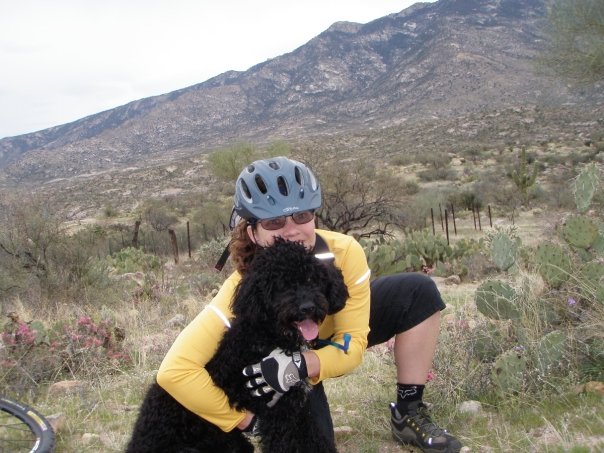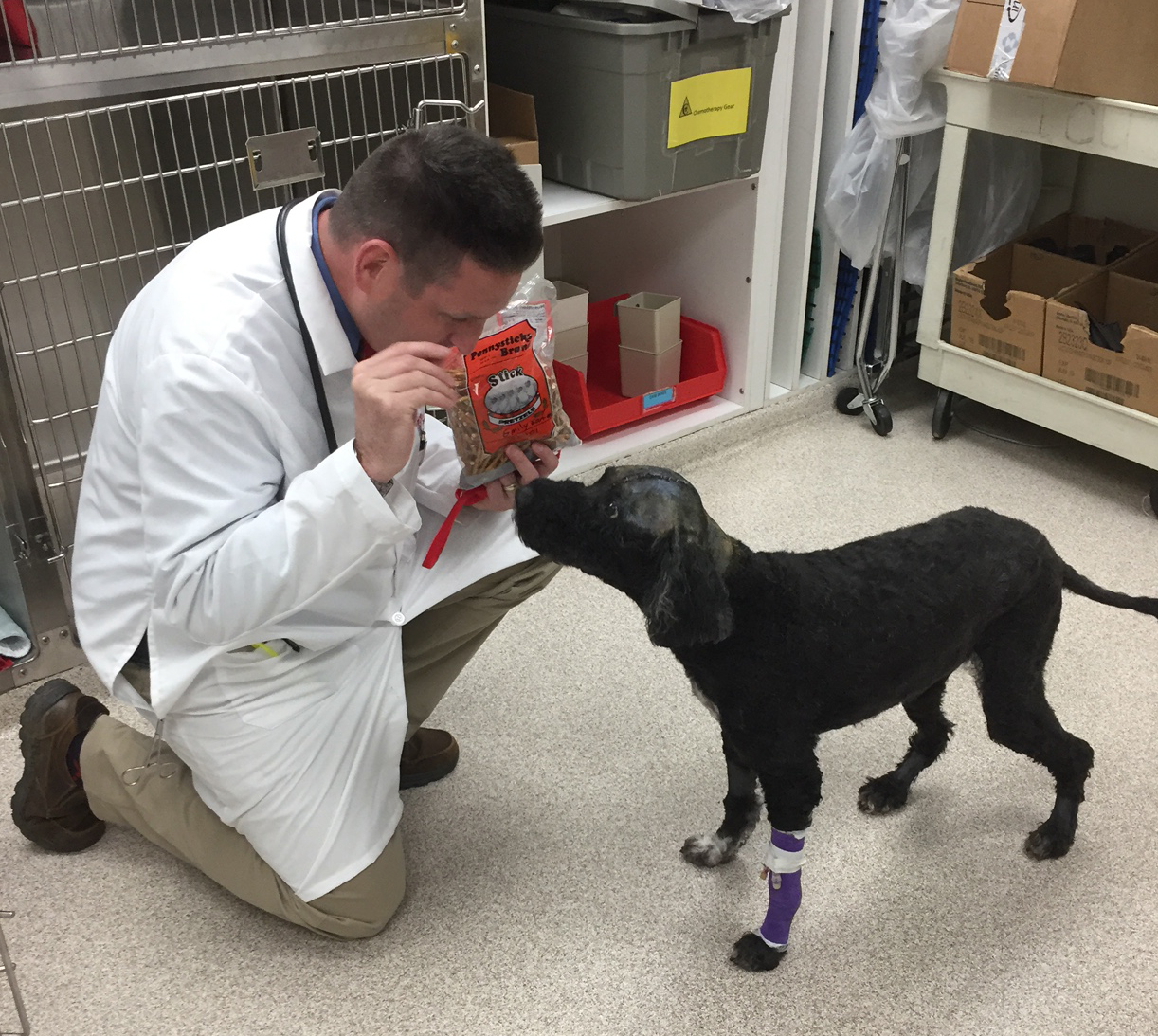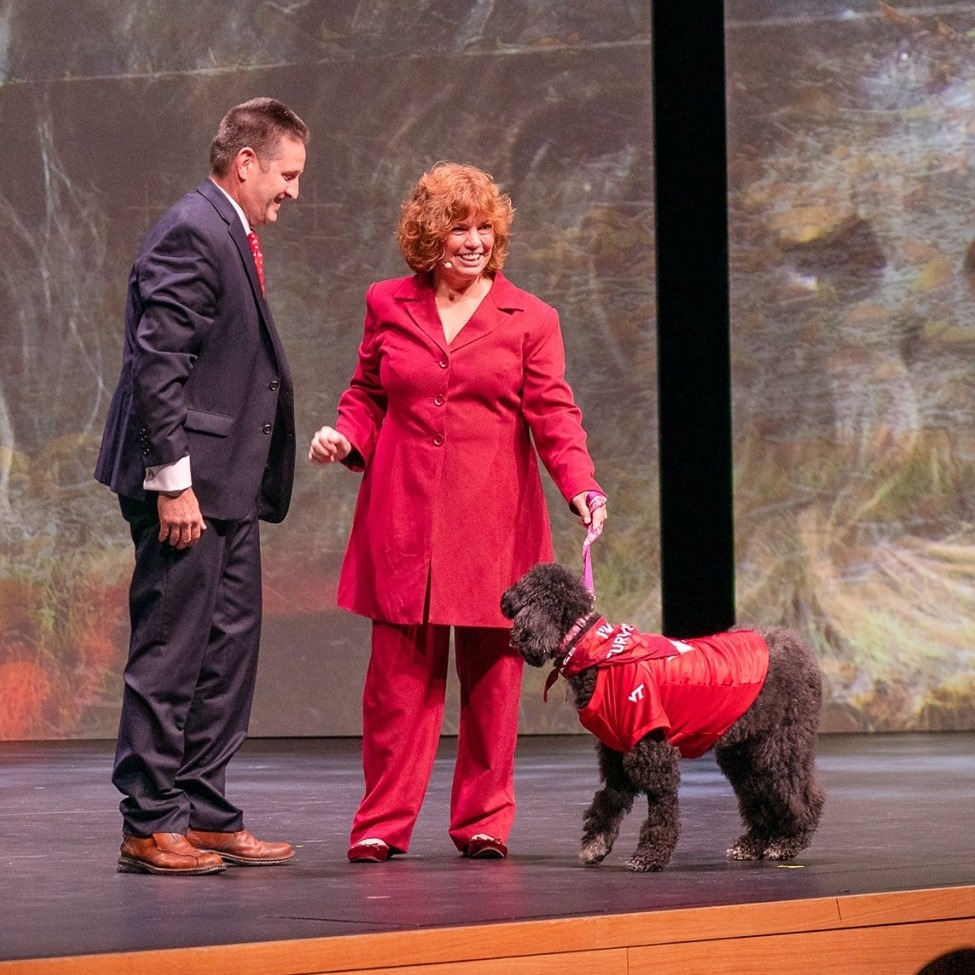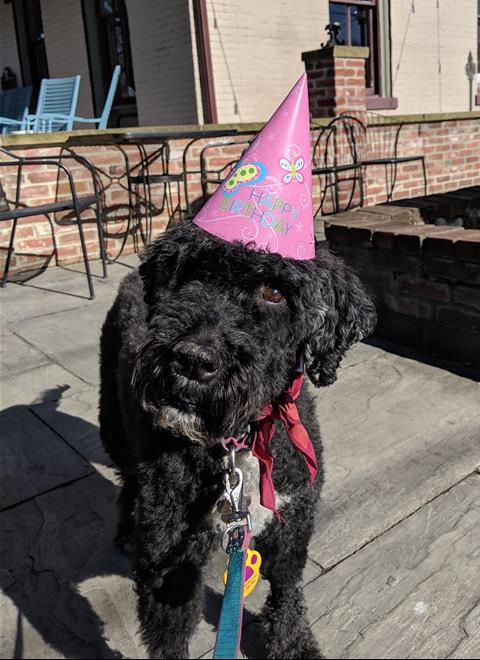It was Laura Kamienski’s friends who told her that she had to get a
Portuguese Water Dog.
“Those friends were right,” Laura says of her first of the breed, named Emily. “These dogs exude joy.” Emily turned out to be the support Laura needed to navigate a new life in the aftermath of a divorce. “For her first four years, it was just me and Emily,” she says. And Emily was there for her. When Laura was actively mountain biking, “Emily
would dance through the desert with me, like a prima ballerina,” she says.
“Portuguese Water Dogs are generally very silly … [but] she had an odd dignity about her,” Laura says. Emily was tireless, with a real stubborn streak, but in a nice way. There was a time when Laura had to spend more than 45 minutes trying to coax a bouncy, happy and yes, stubborn, Emily back into the Jeep after she’d already run alongside Laura’s mountain bike for more than 20 miles that day in the desert. Emily’s strong personality, her energy and her joy made the brain cancer diagnosis in 2018 that much more shocking.
Finding Emily's Tumor
Emily’s glioblastoma was diagnosed in a veterinary hospital, but it didn't start with the tumor. Ten-year-old Emily was visiting Pittsburgh Veterinary Specialty & ER Center (PVSEC) to see a veterinary orthopedic surgeon, John Payne, DVM, MS,
DACVS, who’d performed surgery to repair a torn anterior cruciate ligament (ACL) in Emily’s knee the year before. Following the surgery, Emily maintained her boisterous, high-energy lifestyle and tore the ACL in a different knee.
During a visit to the hospital to diagnose the new knee injury in February 2018, Emily had a single seizure, but recovered quickly. Laura decided to take a short vacation to celebrate Emily’s birthday in March of that year. That's where Emily
experienced a second seizure.

IMAGES:
Emily and Laura. The pair enjoyed an active lifestyle, going on hikes, bike rides and boating trips.
“We rushed home to Pennsylvania from North Carolina,” Laura says, who then expediently took out a loan to pay for an MRI (magnetic resonance image) of Emily’s brain at PVSEC in April 2018. The diagnosis brought Laura to tears: glioblastoma,
an aggressive cancer of the brain or spinal cord.
The outlook was not good. Emily was given just months to live, even with chemotherapy. While Laura was willing to find the money for the care, she wondered whether it would be the right choice to put her 10-year-old dog through the treatment.
The Clinical Trial
Luckily, Dr. Payne presented another option. He told Laura about a clinical trial for a new drug to treat canine glioblastoma at
Virginia-Maryland College of Veterinary Medicine at Virginia Tech. If Emily’s was the right kind of tumor for the study,
Virginia Tech’s John Rossmeisl, DVM, MS, DACVIM (Neurology), could perform the new treatment to try to treat her aggressive cancer. The school’s clinical research coordinator helped Laura find a local organization to cover the cost of
another MRI at Virginia Tech to determine if Emily was eligible.
The new MRI verified that the corticosteroids Emily was taking reduced brain swelling, and a biopsy of the tumor in Emily’s frontal lobe helped verify that the molecular targets of the new brain cancer treatment had a chance of working.
In May 2018, just weeks after Emily's initial diagnosis, Laura drove her favorite Portuguese Water Dog in the world to Virginia Tech for the one-time treatment. “That first stay, when I left her there for treatment, was the longest I’d been away from her since I adopted her,” she says.
IMAGE: Dr. Rossmeisl giving Emily pretzels. “Emily is a totally lovable, personable dog,” says Dr. John Rossmeisl. After he got the inside scoop from Emily’s owner, Laura, that pretzels were the way to the Portuguese Water Dog’s heart, he was in: "After that, she just followed me around like she was my dog."
The drug, administered to 17 dogs, took as long as 12 hours to work for some patients but took just three hours for Emily. The molecularly targeted drug therapy works by doing two things well, says Dr. Rossmeisl: both “targeting” and “killing”
the cancer cells without harming normal cells. The targeting part of the drug recognizes and binds to proteins that are only present on the surface of brain cancer cells. After the drug finds the right cells, it carries a highly potent, genetically
modified bacterial toxin inside the cells, poisoning and killing harmful brain cancer cells.
When Laura returned to Virginia from her home in Pennsylvania after 10 days, she said Emily looked a bit like a “Frankendog,” with her head partially shaved and showing big surgical staples where the medicine had been slowly administered
over hours during treatment.
“I’d brought her a little hat to wear, because it was late spring and warm and I didn’t want her head to get sunburned,” she says. As part of the study, Laura needed to drive Emily back and forth to Virginia Tech (a five-hour
one-way trip) every six to eight weeks for a year, but she says she grew to love her short stays in Blacksburg.
At each visit, Emily received a full physical and neurological exam as well as lab work and a new MRI under anesthesia. The first follow-up MRI just weeks after the initial treatment showed that Emily’s tumor had shrunk by more than 90%. Even
better? It has never grown since.
“I would say Emily had an exceptional response,” Dr. Rossmeisl says, adding that the drug is now currently in development for clinical use in dogs. For future
human applications, he explains that there are more things to address with the Food and Drug Administration before clinical trials can begin: “I’m excited, I hope this drug will be widely available to dogs.”
PHOTO: Dr. Rossmeisl and Laura on stage with Emily during a fundraising event at Virginia Tech.
Emily today
Laura is so happy that veterinary specialists like Dr. Payne keep up on clinical drug trials out in the world that pets might qualify for: “How lucky that my orthopedic guy in Pennsylvania happened to know about a clinical trial at Virginia Tech
that just happened to work for Emily’s tumor.”
Pet owners should know that treatments like these—clinical trials, cutting-edge technologies and newly developed medicines—are out there for pets. “A lot of pet owners may not use them because the costs can be high,” Laura says,
“but the outcomes can be so favorable.”
For Laura, spending the time and money on Emily wasn’t a difficult choice: “I owed Emily my life. No amount of money or action can repay that.”
Emily still takes medication to help prevent seizures and pain medicine for her back legs (in her fragile condition, Emily never did get that knee replaced). Laura takes Emily to visit her primary-care veterinarian, Dr. Cheryl Haywood, at least once every
six months for a check-up.
IMAGE: Emily's first birthday after treatment. Veterinary specialist Dr. John Rossmeisl says Emily is doing well, with her glioblastoma tumor more than 90% smaller after treatment with a drug that was then in clinical trials.
Three years after her initial diagnosis, Emily, now 13, is still enjoying life at home with Laura her two younger canine siblings. Emily has been featured in a fundraising presentation at Virginia Tech, appearing on stage with Dr. Rossmeisl dressed in
a Virginia Tech Jersey. She even showed up in a
CBS story after Sen. John McCain’s death from the same type of cancer—glioblastoma.
There are tremendous possibilities every day when general practice veterinarians like Dr. Haywood refer patients with special needs to veterinary specialists like Drs. Payne and Rossmeisl.
“A brain tumor for a dog is not the end of the road,” says Dr. Rossmeisl. “I just want pet owners to know that there is mounting evidence that suggests that treatment like radiation and surgery can help, and veterinary specialists do
this stuff every day.”
...
Curious about clinical trials for your pet’s unique diagnosis? Check out the American Veterinary Medical Association's Animal Health Studies Database.
Photos courtesy of Laura Kamienski




